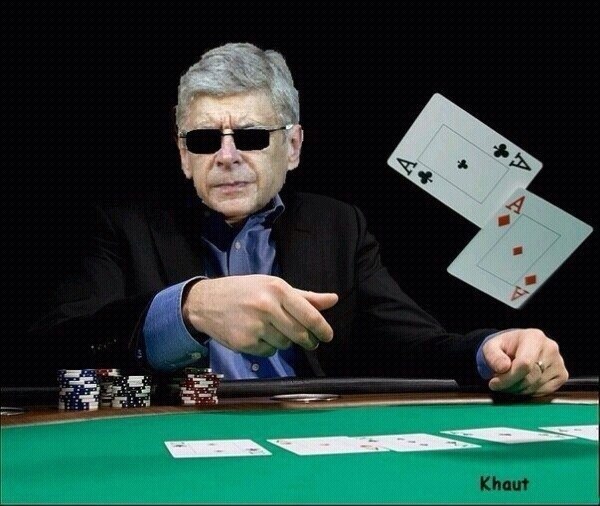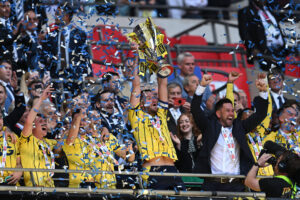Looking into the Arsene Wenger history Back in the summer of 2012, Alex Ferguson paid Arsène Wenger the highest of tributes in claiming that the Frenchman could run a poker school in his native Govan after experiencing his haggling tactics over the transfer of Robin Van Persie that summer. It’s a compliment that might not have been appreciated by many Arsenal fans after witnessing the trauma a third big name exit from N5 in successive seasons. Wenger remarked that only time would tell who got the best out of that very deal.
For part one of this look at Arsène Wenger’s Transfer Poker School, click here.

A Brief Arsene Wenger History: Wenger’s Transfer Poker School – Part Two
The transfer saga of Nicolas Anelka back in 1999 set a precedent with regard to Arsenal having to fight to regain big name star players, which seems to have continued for most summers this side of the Millennium; the focus for this section of the article.
Twelve months on from the Anelka saga, Arsenal lost key players Emmanuel Petit and Marc Overmars, both to Barcelona. A combined sum of £9.5 million was reaped, but the disruption to the side arguably dented Arsenal’s title hopes for a further season, as Alex Ferguson’s United bagged a hat-trick of titles.
In the summer of 2001, Patrick Vieira announced through an alleged third party in the Daily Mirror that he intended to leave Highbury, having been heavily critical of Arsenal’s transfer activity. The Frenchman even threatened to go on strike if his wish to move was not granted, with Manchester United reported to be anticipating a swoop.
In the end, Vieira stayed at the club and played in two further title-winning sides, but a player remaining at the club after being so critical through the press was a scenario which was difficult to comprehend. Speculation about a potential Vieira transfer returned practically every summer before his actual exit from Highbury in the summer of 2005 and from thereafter the attention shifted to his compatriot Thierry Henry.
For the first ten years at the helm, Wenger managed well the fall-out from the loss of big star names to clubs perceived bigger than Arsenal on the European stage. Though Anelka was part of a Real Madrid side which won the Champions League, he became an equally troublesome figure at most of the clubs which he joined for the following decade, which made offloading him at the price achieved look like the deal of the century.
Similarly, the income from that deal, as well as the sales of Emmanuel Petit and Marc Overmars, aided the introduction of Thierry Henry, Robert Pires, Sylvain Wiltord and Gilberto Silva—all of whom arguably became bigger figures than the three who left—as well as covering the cost of Sol Campbell’s wages (and a new training ground).
Even the exit of Vieira had the promise of being vindicated when Cesc Fabregas assumed his coveted number four shirt at the age of just eighteen. The biggest dent in Wenger’s armour, however, came with the exit of Ashley Cole to Chelsea in the summer of 2006.
Cole went to Stamford Bridge in part exchange with William Gallas plus £6.25 million. He went on to win eight trophies with the Blues, including the Champions League, whilst Gallas was proven to be too mentally fragile for the Arsenal captaincy he assumed not much longer after joining the club, as well as being involved in some farcical run-ins with team-mate Samir Nasri.
That same year, Arsenal lost a significant amount of experience in the form of Dennis Bergkamp’s retirement, Lauren’s and Sol Campbell’s exit to Portsmouth and Robert Pires leaving on a free to Villarreal. Within two seasons, there were also the exits of other Invincibles such as Freddie Ljungberg, Gilberto Silva and, perhaps most significantly, Thierry Henry.
Unlike the exits of previous stars, the incoming replacements tended not to be of the same quality. Even before the horrific leg break, Eduardo was some way off Thierry Henry; injury prevented the albeit skillful Tomas Rosicky from filling Robert Pires’ number seven shirt with distinction; Gael Clichy was not in Ashley Cole’s league; and Sol Campbell’s loss was never effectively replaced.
Moreover, by the end of the noughties, players agitating for a move from N5 were hardly in the Patrick Vieira and Thierry Henry mould, but were now seeking a big-money move to a perceived bigger club usually after one good season.
Clear examples of this were Mathieu Flamini, Alex Hleb and Emmanuel Adebayor. The latter two reaped the collective sum of £40 million into Arsenal’s coffers and the clubs to whom they were sold hardly got value for money in either instance, but their exits dented the perception that Arsenal were able to fulfil players’ ambitions, particularly as their trophy drought extended well into the next decade.
Tellingly, in the summer of 2011, when Arsenal lost captain Cesc Fabregas and Samir Nasri for the collective sum of £52 Million, both were under the age of 25 and initially touted as a part of Arsenal’s future.
The loss of Robin van Persie to United, as well as Alex Song to Barcelona, twelve months on was the last time to date that Arsenal have experienced a key player making a big-money move elsewhere. Every season since has seen Arsenal’s transfer expenditure exceed transfer income by a considerable sum.
The collective figure of nigh on £40 million reaped from van Persie’s and Song’s departures was immediately reinvested in signing Santi Cazorla, Lukas Podolski and Olivier Giroud, but the marquee signing which saw a change of emphasis on Arsenal transfer policy came at the end of the following summer; German international Mesut Özil’s transfer to Arsenal for £42.5 million from Real Madrid, after a failed attempt to land Luis Suarez from Liverpool for £40 million + £1 earlier in the summer.
One reaction to the Özil effect was that Arsenal led the Premier League for 128 days in 2013/14 and finally ended their trophy drought by winning the FA Cup, even though the holy grail of the Premier League or Champions League titles were no nearer with a familiar fourth place finish and Last 16 exit respectively.
The new era of relative big spending continued, with Alexis Sanchez coming in from Barcelona for £35 million, as well as a £17 million swoop for Danny Welbeck from Manchester United in the summer of 2014. One year later, the Gunners also bagged Keeper Petr Cech from Chelsea. Arsenal were now seen to be poaching players from clubs who were predators for their own talent in the preceding years, even if the players they bought were seen as surplus to requirements by their clubs.
The 2016/17 season saw a net spend of £87.25 million with the introduction of Granit Xhaka from Borussia Monchengladbach, Shkodran Mustafi from Valencia and Lucas Perez from Deportivo La Coruna. This was overwhelmingly the biggest net spend on transfers in one season during the Wenger era. None of the three, however, were considered a run-away success last term and conversely, 2016/17 also brought Arsenal’s lowest ever league finish under Wenger and a failure to qualify for the Champions League.
As an income comparison, within the Champions League Arsenal were guaranteed at least £11.25 million in prize money for a Champions League group phase appearance, while reaching the same stage in the Europa League receives just £2.3 million. This also comes with a loss in profile for potential sponsors and corporate partnerships, as well as in attracting quality new players to the club.
It will be interesting, therefore, to see whether this expected drop in revenue will see an end to Arsenal’s net transfer spending in recent seasons. Thus far, Arsenal have forked out £45 million to acquire the services of Alexandre Lacazette from Olympique Lyonnais, as well as signing Sead Kolasinac from Schalke on a free transfer. Rumours abound as to who else will come to North London, as well as who will depart to free up any funds which are needed.
The history of Arsène Wenger’s transfer dealings and his willingness to balance the books probably means that someone is on the way out this summer, with Chilean star Alexis Sanchez the one whom Arsenal fans would least like to see on his way out. By valuing him at £80 million, Wenger is at least ensuring that he doesn’t lose his star player on the cheap before the expiry of his contract.
The exit of Alexis, however, would again return the perception that Arsenal are a selling club with regard to top talent. This time around, Wenger seems to be intent on holding his star man to his contract going into the last season before its expiry.
Sanchez’s latest wage demands are reportedly for £400,000 a week, which would even exceed the pay of the likes of Cristiano Ronaldo and Lionel Messi. Quite possibly, Arsenal will want to make themselves look more enticing through quality signings and a strong performance in the league, that they might entice Alexis to compromise on the wages front and sign a new contract by the next transfer window.
Similarly, if Arsenal have a poor first half of the season and the new batch of signings do not live up to expectations, the advantage would fall to Alexis in contract negotiations, as well as Manchester City, who could get their man on a free transfer next summer. As Wenger remarked back on the van Persie saga in 2012, only time will tell who’s going to get the best out of this situation.
Main Photo






